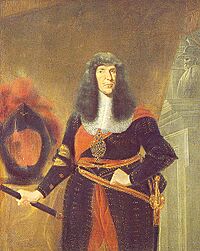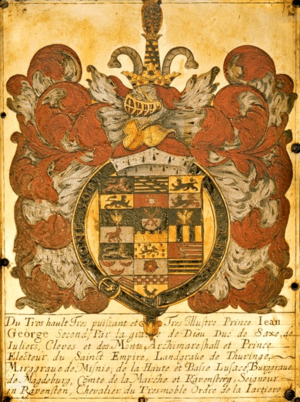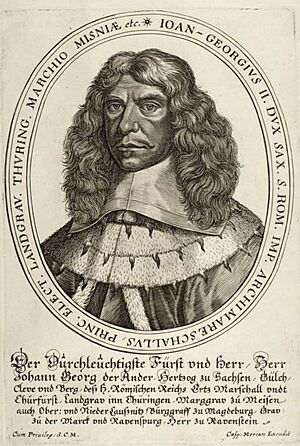John George II, Elector of Saxony facts for kids
Quick facts for kids Johann George II |
|
|---|---|

Portrait by Johann Finck, 1675.
|
|
| Elector of Saxony | |
| Reign | 8 October 1656 - 22 August 1680 |
| Predecessor | John George I |
| Successor | John George III |
| Born | 31 May 1613 Dresden, Electorate of Saxony, Holy Roman Empire |
| Died | 22 August 1680 (aged 67) Tübingen, Duchy of Württemberg, Holy Roman Empire |
| Burial | Cathedral of Freiberg |
| Spouse | Magdalene Sybille of Brandenburg-Bayreuth |
| Issue | John George III, Elector of Saxony |
| House | House of Wettin |
| Father | John George I, Elector of Saxony |
| Mother | Magdalene Sybille of Prussia |
| Religion | Lutheran |
| Signature |  |
Johann George II (born 31 May 1613, died 22 August 1680) was an important ruler known as the Elector of Saxony. He led the region of Saxony from 1656 to 1680. He was part of the House of Wettin, a very old and powerful family.
Life of Johann George II

Johann George II was the third son of John George I, Elector of Saxony. He was the oldest son who lived to become an adult. His mother was Magdalene Sibylle of Prussia. When his father passed away on 8 October 1656, Johann George II became the new Elector of Saxony.
In 1657, Johann George made an agreement with his three brothers. This agreement helped prevent arguments over their different lands. Later, in 1664, he became friends with Louis XIV, the King of France. He even received money from the French king.
However, some people in Saxony did not like France. Because of this, Johann George sometimes also listened to the Holy Roman Emperor, Leopold I. He tried to keep a balance between these powerful leaders.
Johann George II was most interested in music and art, not so much in politics. He made Dresden a famous center for music in Germany. He invited many musicians and artists from other countries to his court. His capital city was always busy with music events and other celebrations. He even ordered the building of the first opera house in Dresden, called the Opernhaus am Taschenberg.
In 1658, Johann George joined the Fruitbearing Society. This was a group focused on improving the German language and literature. Duke William of Saxe-Weimar helped him join this society.
Because he spent so much money on the arts, Johann George had to give more control over money matters to the local government in 1661. This decision helped create the financial system that Saxony used later on. His government was not as strong in creating a powerful, single ruler or a large army as some other places like Bohemia or Prussia.
Johann George's time as Elector saw Saxony slowly recover after the Thirty Years' War. New businesses and factories started to grow. These included textile production, coal mining, and glass making. Silver mined locally helped fill the empty treasury. The Leipzig Trade Fair also helped the economy.
Johann George died in Freiberg on 22 August 1680.
Family Life
On 13 November 1638, in Dresden, Johann George married his cousin, Magdalene Sybille of Brandenburg-Bayreuth. They had at least two children:
- Erdmuthe Sophie (born 25 February 1644, died 22 June 1670). She married Christian Ernst, Margrave of Brandenburg-Bayreuth in 1662.
- John George III (born 20 June 1647, died 12 September 1691). He became the next Elector after his father.
They also had another child, Sibylle Marie, who is thought to have died when she was very young.
See also
 In Spanish: Juan Jorge II de Sajonia para niños
In Spanish: Juan Jorge II de Sajonia para niños


